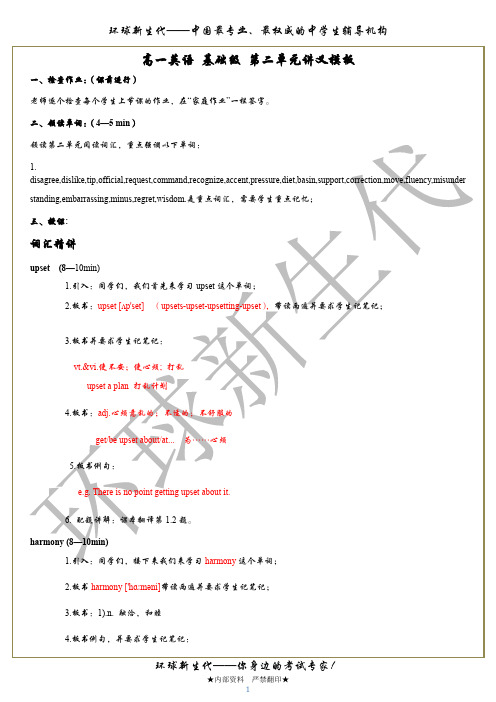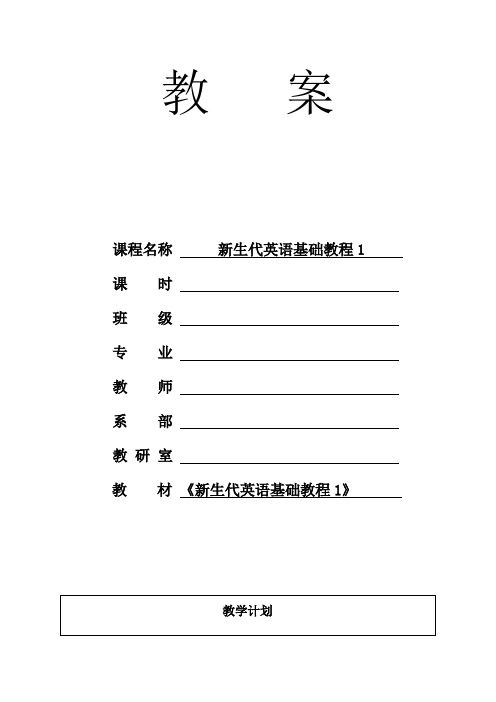新生代英语基础教程2Unit2_电子教案
- 格式:docx
- 大小:26.11 KB
- 文档页数:15



教案课程名称新生代英语高级教程2 课时班级专业教师系部教研室教材《新生代英语高级教程2》12345678910补充教学资源Vocabulary Builder参考译文凯文:嗨,珍妮。
最近怎么样?珍妮:还是老样子。
你看到新款乐桃笔记本电脑(Peachbook)了吗?看起来棒极了。
凯文:嗯,我昨晚看到了。
你想要哪一款?珍妮:我想要13英寸的那一款。
它有16G的内存和万亿字节的存储空间。
凯文:听起来不错,但也很贵吧。
它们卖多少钱?珍妮:大约1,299美元。
凯文:1,299美元!太贵了。
我想我还是继续用我的旧特萨斯(Tasus)吧。
珍妮:那台老电脑!你真的需要买一台新的,凯文。
凯文:我知道,但我的特萨斯仍然能正常工作。
我认为现在买台新电脑是不合理的。
珍妮:好吧,我一定要买一台新款乐桃笔记本。
凯文:我想我宁愿把这笔钱用来度假。
珍妮:我不这样认为。
比起度假我更想买一台新电脑。
11Show Time参考译文桑切斯夫人:嗨,亲爱的。
你在干什么呢?桑切斯先生:刚刚我在看电脑广告。
桑切斯夫人:电脑广告?看它做什么?桑切斯先生:我想给赫克托买台电脑。
他上学能用得着。
桑切斯夫人:真有这个必要吗?桑切斯先生:现在跟以前不一样了,亲爱的。
有台电脑就像有纸有笔一样常见。
桑切斯夫人:好吧,也许你是对的。
但买台电脑会不会太贵了?你确定我们可以负担得起吗?桑切斯先生:当然,我们能够负担得起。
我们有一些积蓄。
而且现在有些活动很划算。
桑切斯夫人:真的吗?桑切斯先生:来,你看这儿。
这是一台笔记本电脑,非常轻而且便于携带。
桑切斯夫人:是的,笔记本电脑确实又薄又轻。
桑切斯先生:没错。
这就是重点。
对比一下笔记本电脑跟台式电脑。
桑切斯夫人:比起笔记本电脑,台式电脑要大得多、沉得多。
桑切斯先生:是的,但台式电脑更便宜。
桑切斯夫人:也就是说。
笔记本比台式电脑要小巧,但同时也比台式电脑贵很多。
桑切斯先生:是的。
桑切斯夫人:哪种电脑的内存最大?12桑切斯先生:笔记本电脑的内存比台式电脑要大。

《新时代高职英语(基础模块)2》电子教案问题导入提出问题,引导学生思考、讨论Why is Huawei so successful? In this passage, the author gives us part of the solution to this puzzle. According to the author, some values which define the culture of Huaiwei definitely help its success. These values include customer-first attitude, employee dedication, long-term thinking, and gradual decision-making. Lead the students to the text by asking the pre-reading questions:What are your impressions of Huawei?Which value do you support best for a company?课堂阅读播放"New Words and Phrases"视频(详见教材),讲解新单词播放视频"Text A"(详见教材),给学生5分钟阅读课文"The Key to Huawei’s Success"(详见教材)The whole text structurally goes like this: The author introduces the theme in the first paragraph—Huawei’s success is partly owing to the specific values. And then the author gives some detailed information about these values and a simple summmary. The text can be divided into three parts.阅读课文播放视频"Huawei—Who Are We"(详见教材)分析课文"The Key to Huawei’s Success"中的难句和语言点1 Strong leaders provide a sense of purpose for people, and Ren Zhengfei is no exception. (Para. 2)a sense of ……感,of后加名词e.g. a sense of urgency 紧迫感 a sense of humor 幽默感a sense of purpose 使命感e.g. People need to discover a sense of purpose.人需要去发现某种使命感。

新生代英语基础教程2课件(一)新生代英语基础教程2课件介绍•本篇文章旨在探讨《新生代英语基础教程2》的课件内容及其相关特点。
第一章:课件概述•本章对《新生代英语基础教程2》的课件进行整体描述和概括。
1.1 课件内容•介绍《新生代英语基础教程2》的课件所包含的主要知识点和话题。
1.2 教学目标•解释课件的教学目标和重点,帮助学生明确学习目标。
第二章:课件结构•本章将从整体上对《新生代英语基础教程2》的课件结构进行详细分析和说明。
2.1 单元划分•对每个单元的划分进行介绍,展示课件的组织结构。
2.2 教学模块•着重讨论课件中的教学模块,介绍每个模块的内容和形式。
第三章:课件特点•本章将从几个方面分析《新生代英语基础教程2》课件的特点和优势。
3.1 多媒体教学•讨论课件中多媒体元素的应用和效果,如音频、视频等。
3.2 互动性•强调课件中互动性的设计和实现,提升学习效果和学生参与度。
3.3 个性化学习•探讨课件提供的个性化学习资源和策略,满足不同学生的需求。
结论•总结全文,强调《新生代英语基础教程2》课件的重要性和价值。
•希望读者能够从本文对课件特点的分析中受益,进一步探索和应用好该课件的教学资源。
新生代英语基础教程2课件介绍•本篇文章旨在探讨《新生代英语基础教程2》的课件内容及其相关特点。
第一章:课件概述•本章对《新生代英语基础教程2》的课件进行整体描述和概括。
1.1 课件内容•《新生代英语基础教程2》的课件内容包括英语基础知识、听力、口语、阅读、写作等核心模块。
1.2 教学目标•该课件旨在帮助学生掌握英语的基础知识和运用能力,培养学生听说读写的综合能力。
第二章:课件结构•本章将从整体上对《新生代英语基础教程2》的课件结构进行详细分析和说明。
2.1 单元划分•课件按照单元进行划分,每个单元包含多个课时,旨在系统、有序地展示英语知识和技能的学习过程。
2.2 教学模块•每个单元内的教学模块包括教学导入、新词学习、对话练习、语法讲解、阅读理解、口语表达、写作等环节,全面拓展学生的英语学习能力。

教案课程名称新生代英语基础教程1 课时班级专业教师系部教研室教材《新生代英语基础教程1》WeatherShow Time“It’s raining hard.”ReadingFun facts on British WeatherChat TimeDo you mind if I borrow your umbrella WritingA weather forecastGrammarPresent continuous tenseMy StoryThe weathermain Have students look at the picture and ask them to tell you as much as they can about it. Then, go through the questions and complete each answer.Read the paragraph together and check their answers.Have the students listen and repeat the words. Ask the students whichweatherwords they know and which they aren’t sure about. The most difficult words on this list are probably poncho and canceled. If you have a real poncho, it may be good to bring it to class. For canceled, you can give an example of when school was canceled recently, perhaps due to a public holiday or poor weather. Try to relate the vocabulary to students’ lives as much as possible.Talk about weather conditions with students. Ask questions like “Do you like a rainy day” Students should answer in a complete sentence beginning with “I like/don’t like a …day.”Finish the exercise and check their answers.improve For Exercise C, tell the students that they will hear a weather forecast. Explain that a forecast is when people try to predict (or guess) what the weather will be. Review the words describing weather with students like sunny, rainy and stormy.Show some examples to prime the students for the listening. Now, listen to the forecast. Have students fill in the correct answers, pausing the recording if necessary. Check their answers andlisten again.Read though Words and Expressions. Ask them questions about their favorite weather and then have them practice such conversations in pair.For exercise D, the teacher can design a game. Divide the class into six groups, each group choosing one task. Then students select nouns that can go with the adjectives in question. Use these words to make sentences or make up a small story.skills First, have the students watch the pictures and read statements below. Ask basic comprehension questions such as, “Who are the main characters in this video” “Where are they” “What are they doing” “Why are they doing that” “How are they doing it” Try to match each statement to the picture.Next, have students take turns in explaining what is happening in each picture. You can do the first picture, and then have a more confident student try the second one. To make it more fun, you could choose two students, and then have them race to explain what is happening in the picture. The student with the fastest and best explanation wins.improve For Exercise B, have students read each statement. Play the video and remind them to pay attention to how Naomi, Mateo and Hector describe the weather. Then have students finish the exercise and check their answers. Ask students why statement F is wrong.Before doing Exercise C, you may ask students to guess the missing words. Then play the video again. You can pause the video when you reach the part of the dialogue with missing words and have students call out the answers. Check their answers and have them read the dialogue. (Ask three students to role-play or have boys read Hector’s lines while girls Naomi’s and the teacher acts as Mateo.)Finally, for Exercise D, have students put the events is the correct order to complete Exercise D. Check their answers and read the sentences in correct order together.If time permits, play the video but turn off the volume. Have students dub the characters.improve First, have the students read text quietly and read through sentences in Exercise A. After they have finished the exercise, check their answers and ask them for proofs from the text.Ask students to read the text again in three minutes. Then have them finish the Exercise B. Make them understand that they don’t need figure out the meaning of every word to answer the questions.For Exercise C, have students read new words in boxes. Correct their pronunciation. Then have them finish the exercise. Ask students to read the complete sentences and correct their mistakes.their For Exercise D, ask students to read English expressions. If they encounter new words, encourage them to guess the meaning. Then you may explain what they fail to understand. Have them finish the exercise and check their answers. Finally, you say Chinese proverbs and let students say corresponding English ones.improvewriting skills For Exercise A, explain to students that they will hear a conversation between two people discussing the weather. Encourage them to guess the missing information. Tell the students to listen carefully and write down what they hear in the blank spaces. If necessary, pause the recording so that students have time to write. Next, have students practice asking a favor in pairs, monitoring them while they do so.For Exercise B, have students practice the dialogue in example inimprove weather Have students read the picture and teach them how to get information from a weather forecast picture. Have them look through words in the boxes and fill in the blanks. The teacher gives necessary explanation, such as the pronunciation of 16℃. Check their answers and have them read sentences.Have students finish Exercise B and encourage them to discuss with partners.For Exercise C, divide the class into several groups. Group members discuss and predict the weather condition on weekends. Look back to Exercise A and B as clues. Invite representatives to perform a weather forecast.Explain to students that we use the present continuous tense to describe an action happening now or in the very near future. Give some examples such as “You are sitting in class now.” “I am teaching you pair. Write more phrases such as “close the door, open the window, borrow your bike on the blackboard”for more practices.For Exercise C, have students perform a dialogue about asking for a lift in a rainy day. Monitor their performance and provide help when necessary.now.” In addition, point out that we use it for actions that happen “close to now,” for example, today or tonight. Again, give examples, asking your students “What are you doing today / tonight”Remind students that the structure we use for this tense is “Subject + be + v-ing.” Write this structure on the board and have students practice out loud. You may also want to briefly explain the rules of adding “ing.” Students essentially need to know the rules regarding “e” (cut e add ing), “ie” (cut ie add ying), such as have and take; and consonant–short vowel–consonant (in which we double the last consonant), such as put and run.Once students seem comfortable using the tense, have them do Exercise A, checking for mistakes when they are finished.Have students make up a short story using continuous tense with the picture and words given. Ask questions and answer based on the picture. Do this in pair or in group.improve ability T ell the students that they will see a video in which real people talk about the weather in the places they come from. A place students may not know is “Jamaica.” Now watch the video and have students complete the true or false statements. In some cases, you may need to pause thevideo to help the students. Now havestudents tell you the answers,correcting any mistakes.Watch the video again and havestudents write in the missing words,pausing the video if necessary.Check the students’ answers,correcting any mistakes.T here are several ways to conductExercise C. students may answers thequestions by themselves and make upa short passage according to theiranswers. Or students make updialogues in pair. Or have studentsmove freely in the class and askclassmates the questions. Invitesome students to do a report in frontof the class.课后学习设计作业Finish all the exercises in Unit 2.Read the text in this unit again andtry to summarise its content.Write a weather forecast according tothe local weather broadcastprogramme.课后总结与反思补充教学资源VOCABULARY BUILDER参考译文您正在收听的是您最喜欢的广播电台,“波浪”调频广播。
新生代英语基础教程Unit电子教案教案课程名称新生代英语基础教程1 课时班级专业教师系部教研室教材《新生代英语基础教程1》1345678补充教学资源VOCABULARY BUILDER参考译文SHOW TIME语言解析1. It’s ten after three.三点过十分了。
ten after three 三点过十分,这个短语相当于ten past three。
英语中表示“几点过几分”(半小时以内)可用after,也可用past;而表示“几点差几分”则用to,通常先讲分钟,再讲小时, 即after / past 或to前面的数字为分钟,后面的数字为小时。
e.g. 5:10 ten past five (ten after five)10:05 five past ten (five after ten)5:50 ten to six9:45 fifteen to ten2. The class is canceled because of the storm. 因为暴雨,课被取消了。
because of意思是“因为”,是一个介词短语,后面跟名词或动名词,构成介宾结构。
because是连词,后面跟句子。
9e.g. The plane didn’t take off because of the heavy rain.因为大雨,飞机没有起飞。
The plane didn’t take off because it was raining heavily.因为下大雨,飞机没有起飞。
3.Nobody came to class—except us.除了我们几个,没有人来上课了。
except 表示“除……之外”,强调所排除的“不包括在内”,一般表示同类之间的关系。
besides表示“除……以外还……”,有“不但……而且……”的意思。
e.g. The library is open every day except Mondays.除了星期一,图书馆每天都开放。
教案课程名称新生代英语基础教程2 课时 _____________________ 班级 _____________________ 专业 _____________________ 教师 _____________________ 系部 _____________________ 教研室 _____________________教材《新生代英语基础教程2》1234567补充教学资源VOCABULARY BUILDER8SHOW TIME➢语言解析1. Can you put them away for me, please? 你能帮我收起来吗?put away①(使用完毕)将某物收起或放入箱子、抽屉等中e.g. Put your toys away in the cupboard, when you have finished playing.你把玩具玩完了以后放进柜子里去。
②存(钱)以备他日之需e.g. She’s got a few thousand pounds put away for her retirement.她存了几千镑以备退休只用。
③吃,喝(大量食物或饮料)e.g.I don’t know how he manages to put it all away.我真不知道他怎么吃得这样多。
2. Are you looking for salesclerks? 你们是要招聘售货员吗?look for 盼望或期待某事物e.g. We shall be looking for an improvement in your work this term.我们期待你这学期功课进步。
3. But do you think you have what it takes to be a sales clerk?9但是你觉得你可以胜任吗?take “需要,要求”,不用于被动语态,常与it连用。
e.g. It takes stamina to run marathon. 跑马拉松需要耐力。